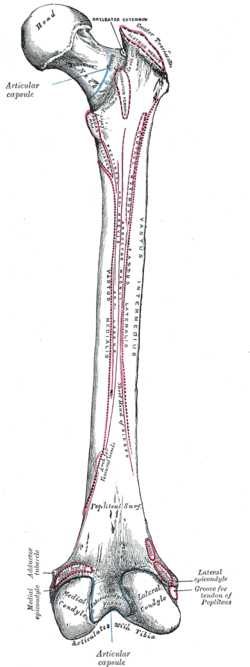Thelinea aspera(Latin:rough line) is a ridge of roughened surface on the posterior surface of theshaftof thefemur.[1]It is the site of attachments ofmusclesand the intermuscularseptum.
| Linea aspera | |
|---|---|
 Right femur. Posterior surface. (Linea aspera not labeled, but region is visible. Medial lip is at left; lateral lip is at right.) | |
| Details | |
| Identifiers | |
| Latin | linea aspera |
| TA98 | A02.5.04.013 |
| TA2 | 1372 |
| FMA | 75101 |
| Anatomical terms of bone | |
Its margins diverge above and below.
The linea aspera is a prominent longitudinal ridge or crest, on the middle third of the bone, presenting a medial and a lateral lip, and a narrow rough, intermediate line. It is an important insertion point for the adductors and thelateralandmedial intermuscular septathat divides the thigh into threecompartments.The tension generated by muscle attached to the bones is responsible for the formation of the ridges.
Structure
editAbove
editAbove, the linea aspera is prolonged by three ridges.
- Thelateral ridgeis very rough, and runs almost vertically upward to the base of thegreater trochanter.It is termed thegluteal tuberosity,and gives attachment to part of thegluteus maximus:its upper part is often elongated into a roughened crest, on which a more or less well-marked, rounded tubercle, thethird trochanter,is occasionally developed.
- Theintermediate ridgeorpectineal lineis continued to the base of thelesser trochanterand gives attachment to thepectineus muscle;
- themedial ridgeis lost in theintertrochanteric line;between the intermediate and medial ridges a portion of theiliacus muscleis inserted.
Below
editBelow, the linea aspera is prolonged into two ridges, enclosing between them a triangular area, thepopliteal surface,upon which thepopliteal arteryrests.
- Of these two ridges, thelateralis the more prominent, and descends to the summit of thelateral condyle.
- Themedialis less marked, especially at its upper part, where it is crossed by thefemoral artery.It ends below at the summit of themedial condyle,in a small tubercle, theadductor tubercle,which affords insertion to the tendon of theadductor magnus.
Development
editThe tension generated by muscle attached to the bones is responsible for the formation of the ridges.
Function
editA number of muscles attach to the linea aspera:
- From themedial lipof the linea aspera and its prolongations above and below, thevastus medialis muscleoriginates.
- From thelateral lipand its upward prolongation, thevastus lateralis muscletakes origin.
- Theadductor magnus muscleis insertedinto the linea aspera,and to its lateral prolongation above, and its medial prolongation below.
- Between the vastus lateralis and the adductor magnustwo muscles areattached:
- thegluteus maximus muscleinserted above,
- and the short head of thebiceps femoris muscleoriginating below.
- Between the adductor magnus and the vastus medialisfour muscles areinserted:
- theiliacus muscleandpectineus muscleabove;
- theadductor brevis muscleandadductor longus musclebelow.
The linea aspera is perforated a little below its center by thenutrient canal,which is directed obliquely upward.[1]
Additional images
edit-
Cross-section through the middle of the thigh.
References
editThis article incorporates text in thepublic domainfrompage 246of the 20th edition ofGray's Anatomy(1918)
- ^abWhite, Tim D.; Black, Michael T.; Folkens, Pieter A. (2012-01-01), White, Tim D.; Black, Michael T.; Folkens, Pieter A. (eds.),"Chapter 12 - Leg: Femur, Patella, Tibia, and Fibula",Human Osteology (Third Edition),San Diego: Academic Press, pp. 241–270,doi:10.1016/b978-0-12-374134-9.50012-x,ISBN978-0-12-374134-9,retrieved2021-02-18